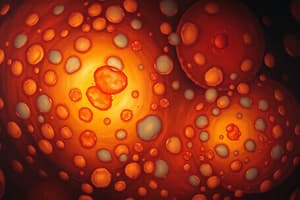Podcast
Questions and Answers
What is a cell?
What is a cell?
The basic unit of life on earth.
Which of the following are main parts of a cell? (Select all that apply)
Which of the following are main parts of a cell? (Select all that apply)
- Nucleus (correct)
- Cell membrane (correct)
- Cytoplasm (correct)
- Cell wall
The cell membrane is impermeable.
The cell membrane is impermeable.
False (B)
What does the nucleus contain?
What does the nucleus contain?
What is the fluid portion of the cytoplasm called?
What is the fluid portion of the cytoplasm called?
What is the primary function of mitochondria?
What is the primary function of mitochondria?
What are the two types of endoplasmic reticulum?
What are the two types of endoplasmic reticulum?
What do ribosomes do?
What do ribosomes do?
Which organelle is known as the 'suicidal bag'?
Which organelle is known as the 'suicidal bag'?
What structure forms the spindle apparatus during cell division?
What structure forms the spindle apparatus during cell division?
What supports the cell and gives it shape?
What supports the cell and gives it shape?
What are microfilaments made of?
What are microfilaments made of?
Which structures are used for cell movement?
Which structures are used for cell movement?
___________ is a jelly-like substance found floating inside the plasma membrane.
___________ is a jelly-like substance found floating inside the plasma membrane.
Flashcards
Cell Membrane
Cell Membrane
The outer coating of the cell, a fluid lipid bilayer that regulates the passage of substances in and out of the cell.
Cytoplasm
Cytoplasm
The jelly-like substance filling the cell, containing cytosol, organelles, inclusions, and the cytoskeleton.
Cytosol
Cytosol
The fluid portion of the cytoplasm, containing water, dissolved solutes, minerals and suspended particles.
Nucleus
Nucleus
Signup and view all the flashcards
Mitochondria
Mitochondria
Signup and view all the flashcards
Endoplasmic Reticulum (ER)
Endoplasmic Reticulum (ER)
Signup and view all the flashcards
Golgi Apparatus
Golgi Apparatus
Signup and view all the flashcards
Ribosomes
Ribosomes
Signup and view all the flashcards
Lysosomes
Lysosomes
Signup and view all the flashcards
Cytoskeleton
Cytoskeleton
Signup and view all the flashcards
Study Notes
Cell Structure
- Cells are the basic units of life.
- Cells are divided into three parts: cell membrane, cytoplasm, and nucleus.
Cell Membrane
- The cell membrane is a lipid bilayer that forms the outer boundary of the cell.
- It regulates the movement of substances in and out of the cell.
- It is very thin (75-100 Å).
- It is elastic and dynamic.
- It is semipermeable.
- Composed of phospholipids (polar head and nonpolar tails).
- Also contains proteins, carbohydrates, and cholesterol.
Cytoplasm
- The cytoplasm is the fluid portion within the cell membrane.
- It is mostly water and contains dissolved substances, minerals, and suspended particles.
- It also contains organelles.
- Organelles are little organs with specific shapes and functions.
- Ribosomes
- Endoplasmic reticulum
- Golgi complex
- Lysosomes
- Mitochondria
- Cytoplasm also contains inclusions that are non-living substances, which store nutrients, and secrete products, or other pigment granules.
- The cytoskeleton is an interlinking protein filament system including microfilaments, intermediate filaments, and microtubules.
Nucleus
- The nucleus is the control center of the cell.
- It contains the cell's DNA (genetic information).
- It protects the genetic material. It directs the synthesis of ribosomes and gene expression.
- It is the location of transcription and DNA replication.
- The nucleus consists of the nuclear envelope (containing pores), nucleoplasm, and nucleolus.
Mitochondria
- Mitochondria are called the powerhouses of the cell.
- They break down nutrients to produce energy in the form of ATP.
- They have an outer and inner membrane.
- The inner membrane has folds called cristae, where enzymes are located to oxidize nutrients and create energy.
- Mitochondria can only be seen with electron microscopy (EM).
Endoplasmic Reticulum (ER)
- The ER is a network of tubules and vesicles that acts as a production and transport unit.
- There are two types of ER:
- Rough ER: has ribosomes attached to its surface, involved in protein production.
- Smooth ER: lacks ribosomes, involved in lipid production.
Golgi Apparatus
- The Golgi apparatus is composed of membranous sacs called cisternae.
- It has two faces: cis (receiving) and trans (shipping).
- It modifies cellular products and tags them for delivery by adding phosphate, sulphate or carbohydrates.
- It's also involved in transporting proteins and lipids.
Ribosomes
- Ribosomes are small organelles found throughout the cytoplasm.
- They are responsible for protein synthesis.
Lysosomes
- Lysosomes are vesicles containing enzymes.
- They break down nutrients, cellular debris, or invading microorganisms like bacteria.
Centrosome
- Centrosomes are organelles consisting of two centrioles.
- They're composed of microtubules, cenexin and tektin.
- The centrosome anchors spindle microtubules to form the spindle apparatus during cell division.
Cytoskeleton
- The cytoskeleton supports the cell and provides its shape.
- It is important for molecule transport, cell division, and cell signaling.
- Types of cytoskeleton:
- Microfilaments
- Intermediate filaments
- Microtubules.
Cilia and Flagella
- Cilia and flagella are hair-like structures that extend from the plasma membrane.
- Flagella are long, used for whole-cell movement.
- Cilia are short, used for moving substances or whole cells.
- Both are involved in cell movement.
Organelles
- Organelles are categorized as either membranous or non-membranous.
Studying That Suits You
Use AI to generate personalized quizzes and flashcards to suit your learning preferences.




